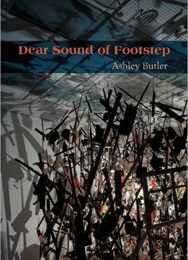Review: DEAR SOUND OF FOOTSTEP by Ashley Butler

Review by LAURENCE ROSS
Writing about cancer is a difficult task, given its ubiquitous—and therefore well-known and well-documented—horror. But in Dear Sound of Footstep, a sequence of essays simultaneously about and not about the death of her mother from cancer, Ashley Butler manages to generate a surprisingly new perspective on this familiar story. While the more conventional personal narrative of her mother’s trials with cancer is certainly present, Butler’s curious, often scientific pursuits run parallel to it, providing two differing modes of investigation that complicate and echo each other, ultimately resonating with the reader in provocative ways.
Dear Sound of Footstep begins with a straightforward account that pushes new imagery out of the well-tread terrain of cancer struggles. There is the mother whose image only emerges from the white sheets with the help of her polka dotted nightgown. There is a rectangle of skin likened to “an aerial view of a fallow crop field” (6). There is dark hair spinning in a bowl of water.
Early on in Dear Sound of Footstep, Butler, in the face of the situation with her mother, becomes disoriented. She wanders over the Manhattan Bridge and then slips into a torrent of memories, visiting a family cottage on the Chesapeake. But these are brief resting places before Butler quickly finds her orientation.
As the collection continues, we find Butler’s focus, ultimately, is space. We are led swiftly from the hospital to the sky where there is a man falling through the clouds, a man who miraculously survives and is left with the imprint of a zipper on his chest, “as if he might later undo himself, peer into a Plexiglas-cased heart” (11). And the images of polka dotted nightgown, rectangle of skin, and spinning hair resound as Butler goes on to discuss the infinity that can be found in monochrome, the physics of flight, and the vortexes that are created without our knowledge.
In an effort to discuss the loss of her mother, Butler begins to leave out direct mention of her mother—as if the only way to gain more insight into her mother is to search elsewhere, away and apart from memory. The mother is kept surprisingly close despite her literal absence. In the essay “The Book of Concealed Hearts”, we are given a collage of scenes and musings (ranging from an abruptly informative museum guard to the phenomena of global dimming) and these vignettes relate to each other in a kind of parataxis, the notion of the mother lingering but unseen. In fact, it is keeping the mother in mind as the sequence of essays progress that lends Butler’s words their poignancy. Butler does not hammer the image of her mother to every subject she explores because she does not have to. Because the mother is there.
It is in this way that the wide variety of subjects Butler explores gain a satisfying weight beyond the subjects’ already inherent interest. The art of Yves Klein, the escape acts of Houdini, the damaged eye of the fastest man on earth—all obtain metaphoric significance. Mirrors, single-action pistols, and miniature portraits become signifiers for the absent mother, the invisible signified. We begin to expect the mother’s eventual emergence from the diverse histories Butler chooses to investigate just as Houdini, Butler tells us, “remains in the coffin originally fashioned for a performance from which, now, forever, he is expected to emerge” (112).
The mother is echoed in everything Butler writes. It seems there is no place Butler can focus her vision in which the mother does not materialize—and there seems to be both comfort and horror in this. Our world, as Butler writes it, is a series of metaphors stretching toward a horizon that we can never and will never reach, but Butler is persistent nonetheless. “Persistence is not the absence of change but a change so slow as to be imperceptible,” she writes (73). And like Ulysses in Tennyson’s poem, Butler is going to sail toward the horizon despite the fact that she will never reach it, despite the fact that, as the metaphors she finds graze the outline of her mother and each line of thought works to serve her image, her mother cannot be recreated by objects—or by essays.
Perhaps these metaphors that continually allow the mother a space in which to exist account for the unease of the final essay in the collection. As Butler explores an anechoic chamber, the notion that nothing will be echoed is a frightening one. It is as if in the chamber, not only will sounds cease to echo, but thoughts as well. The anechoic chamber suggests a space where echo and metaphor will be shut out, where a person will be left to confront a bare reality. There is both horror and comfort in the idea that in this space, without echo and without metaphor, the mother might fade away. Butler writes, “the sound which cannot be accounted for may be an illusion triggered by the brain; this is an environment in which one may find how the body leads itself astray” (115). And I am left to wonder if it is an echo or a metaphor that could lead us back.